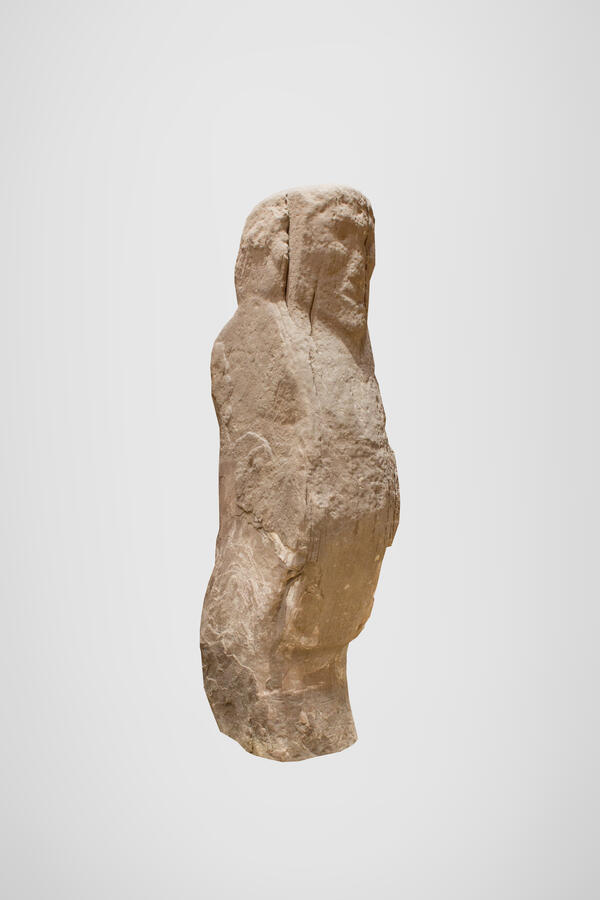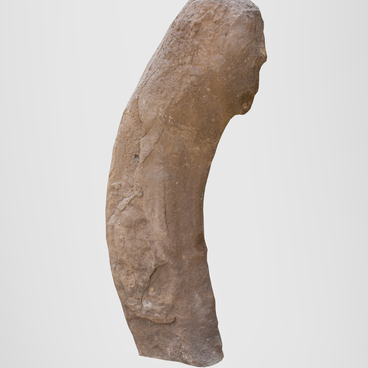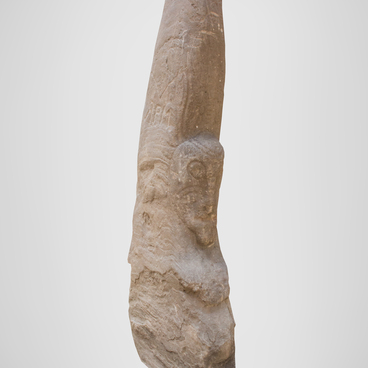The statue “Iney tas” was originally located in one of the stone mounds of the medieval Kamyshtinsky chaatas — the ancestral burial ground of the ancient Kyrgyz. It was located on the left bank of the Ninya River at the headwaters of the Kamyshta River in the Ust-Abakan District of the Republic of Khakassia. The statue was taken to the Khakass Museum of Local History by the archaeologist Albert Lipsky in 1953.
“Iney tas” in Khakass means a “stone old woman”. The statue was made of gray sandstone with an image of a human face engraved in its upper part. The drawing is poorly preserved, since sandstone is more susceptible to weathering than other stones due to its layered structure. However, it can be seen that it depicts an oval-shaped face with a narrow chin. Above the eyes, two curved lines indicate the eyebrows. Their lines go down, smoothly passing into the line of the nose. Under it, a grooved strip depicts a mouth.
Archaeologists suggest that a woman’s face is carved in the stone. To make such sculptures, ancient sculptors took a natural block of sandstone and carefully hewn to give the desired shape. Traces of sandstone processing are clearly visible in its upper part: there you can see traces of pecking. Traces of work on the stone are visible both on the frontal surface and in the central part, where the so-called pregnant belly of the statue is carved in relief.
Residents of Khakass villages in the valleys of the Kamyshta and Ninya rivers traditionally revered the “Iney tas” statue as the personification of the goddess Umai, the patroness of motherhood and childhood. It was believed that the goddess protects children from birth to six years old, protects them from troubles and evil spirits. Smile, crying and even the child’s illness were associated with Umai: if it is there, the child is calm and healthy. If the child was sick, it means that the goddess was not there. The Khakass believed that in this case he could die, and they always invited a shaman. He performed the ceremony and determined whether the child’s soul was stolen by evil spirits.
Shamans were believed to have an inherited gift to heal people. The shaman was a guide between the living and the departed, as well as between the human world and the natural world. They knew how to imitate the voices of animals and birds, in the image of which their spirits-helpers appeared, the neigh of the sacrificial horse, the riding horse of the deity. The process is always watched by ordinary participants in the ritual.
“Iney tas” in Khakass means a “stone old woman”. The statue was made of gray sandstone with an image of a human face engraved in its upper part. The drawing is poorly preserved, since sandstone is more susceptible to weathering than other stones due to its layered structure. However, it can be seen that it depicts an oval-shaped face with a narrow chin. Above the eyes, two curved lines indicate the eyebrows. Their lines go down, smoothly passing into the line of the nose. Under it, a grooved strip depicts a mouth.
Archaeologists suggest that a woman’s face is carved in the stone. To make such sculptures, ancient sculptors took a natural block of sandstone and carefully hewn to give the desired shape. Traces of sandstone processing are clearly visible in its upper part: there you can see traces of pecking. Traces of work on the stone are visible both on the frontal surface and in the central part, where the so-called pregnant belly of the statue is carved in relief.
Residents of Khakass villages in the valleys of the Kamyshta and Ninya rivers traditionally revered the “Iney tas” statue as the personification of the goddess Umai, the patroness of motherhood and childhood. It was believed that the goddess protects children from birth to six years old, protects them from troubles and evil spirits. Smile, crying and even the child’s illness were associated with Umai: if it is there, the child is calm and healthy. If the child was sick, it means that the goddess was not there. The Khakass believed that in this case he could die, and they always invited a shaman. He performed the ceremony and determined whether the child’s soul was stolen by evil spirits.
Shamans were believed to have an inherited gift to heal people. The shaman was a guide between the living and the departed, as well as between the human world and the natural world. They knew how to imitate the voices of animals and birds, in the image of which their spirits-helpers appeared, the neigh of the sacrificial horse, the riding horse of the deity. The process is always watched by ordinary participants in the ritual.



